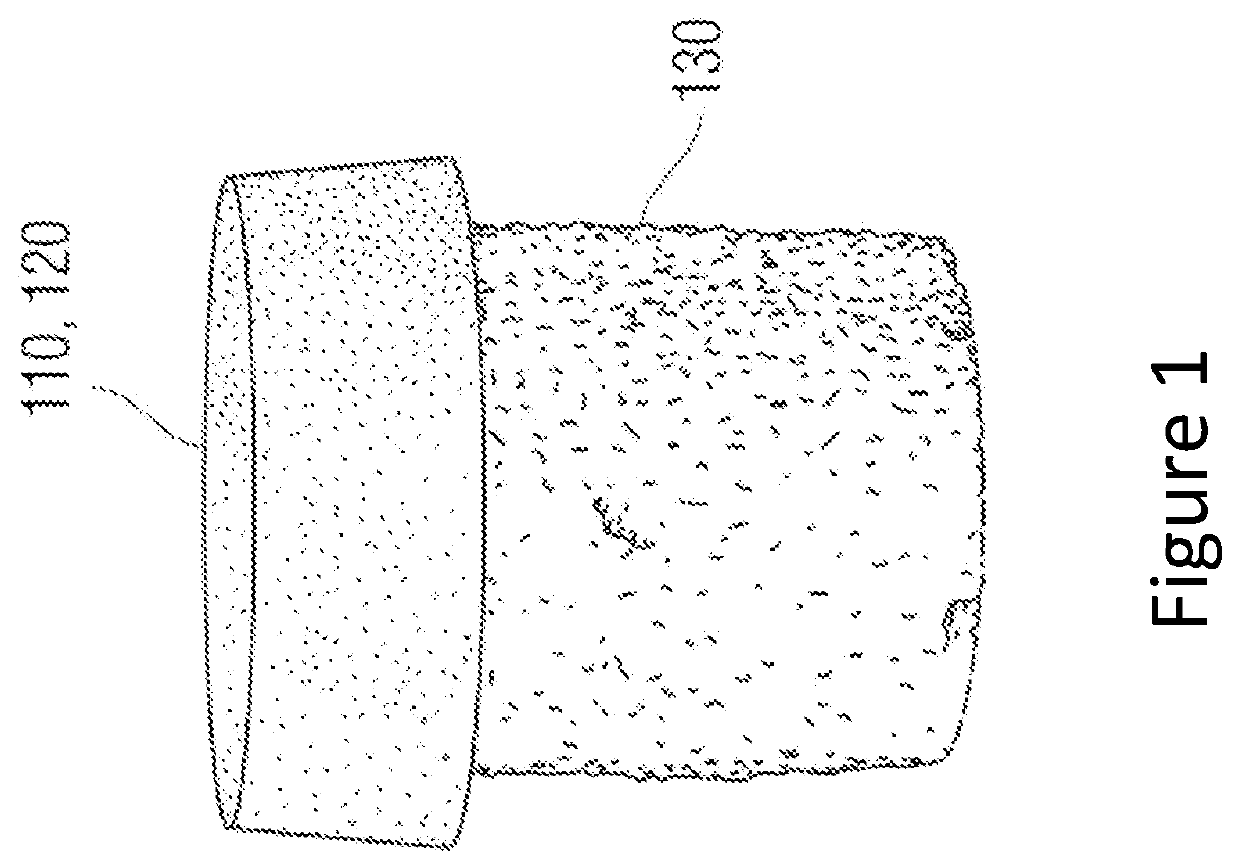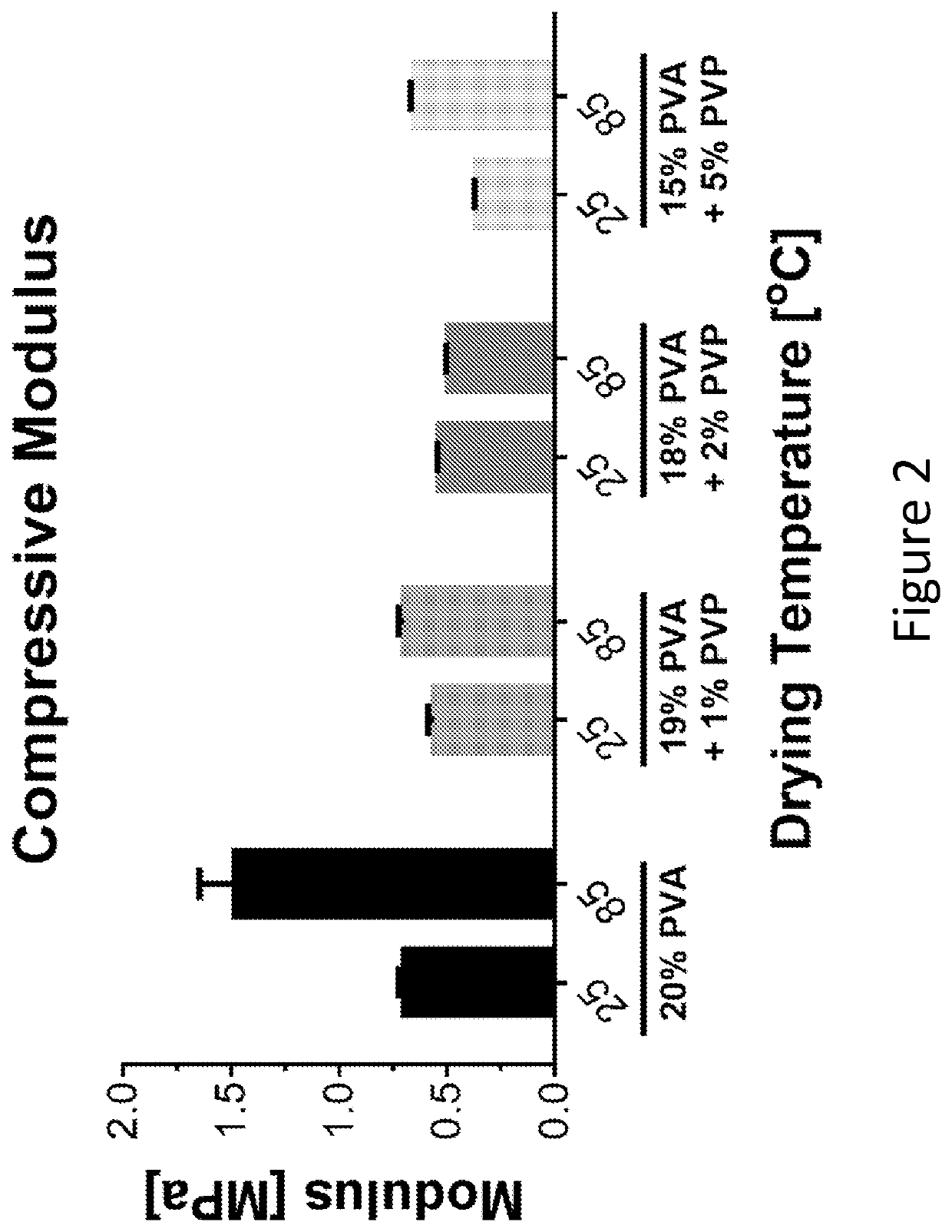Method of and a mold for the manufacture, making and/or production of a multi-component implant, device, construct or material
a multi-component, mold technology, applied in the direction of joint implants, prosthesis, pharmaceutical delivery mechanisms, etc., can solve the problems of limited healing ability, inability to fully heal, so as to maximize integration and maximize the effect of integration
- Summary
- Abstract
- Description
- Claims
- Application Information
AI Technical Summary
Benefits of technology
Problems solved by technology
Method used
Image
Examples
example 1
and Methods for Developing and Testing an Improved Manufacture of the Hydrogel Portion of the Implant (Examples 2-4)
[0232]All handling and fabrication techniques were performed aseptically to minimize contamination with bacteria and other infectious agents.
[0233]In order to obtain a method for the improvement of the properties of the PVA hydrogels, the following variables were tested: (i) temperature, (ii) polymer blends, and (iii) changing the solvent which the PVA monomer was dissolved.
[0234]Method of Manufacture—Identical for all groups: solutions of PVA were created using an overhead stirrer in a mineral oil bath to help maintain uniform solution temperatures. Solutions were stirred until all PVA was in solution (1 to 4 hours). PVA solutions in water were heated to 90° C. and those made in DMSO were heated to 120° C. The PVA solutions were placed in a mold and then subjected to freeze / thaw cycles consisting of a 20 hour freeze cycle at −20° C. and a 4 hour thaw cycle at 23° C. i...
example 2
tion of the Best Polymer Blends
[0236]First, altering the polymer blends and the temperature at which the PVA hydrogels were dried was tested.
[0237]Polyvinyl pyrrolidone (PVP) was chosen as the secondary polymer as it has previously been used to improve the stability of PVA hydrogels (Maher, et al. 2007). For these tests, the total weight / volume (w / v) of polymer to liquid to 20% was maintained and altered the percentages (w / v) of PVP from 0 to 5%. The polymer solutions were dissolved in water and subjected to 6 freeze / thaw cycles. After the completion of the freeze / thaw cycles, the hydrogels were then washed in 100% ethyl alcohol (EtOH) for 24 hours changing the EtOH solution twice. The hydrogels were removed from the solution and dried at either room temperature (23° C.) or 85° C. for 24 hours. The hydrogels were then rehydrated 24 hours prior to performing mechanical testing performed as described in Example 1.
[0238]The results from the mechanical testing showed that the 20% PVA dr...
example 3
tion of the Best Solvents
[0239]Two solvents were chosen to test: 1) double distilled H2O (ddH2O) and 2) dimethyl sulfoxide (DMSO). The solvents were used to create solutions of PVA at concentrations of 25%, 30%, and 35% PVA (w / v). The 35% PVA solutions using ddH2O as a solvent were not able to be made due to the high viscosity of the solution and therefore did not include this group in the results of this study. The solutions were then poured into 100 mm cell culture dishes and underwent 6 freeze / thaw cycles.
[0240]The compressive moduli for PVA hydrogels (tested as described in Example 1) in ddH2O were 0.68±0.07 and 1.35±0.31 MPa for the 25% and 30% PVA groups respectively (FIG. 3). The compressive moduli for the PVA hydrogels in DMSO were 0.39±0.03 and 0.72±0.05 MPa for the 25% and 30% PVA groups, respectively. The modulus for both the 25% and 30% PVA in ddH2O groups were approximately 40% higher compared the corresponding DMSO groups.
[0241]While these data suggested that ddH2O cre...
PUM
| Property | Measurement | Unit |
|---|---|---|
| diameter | aaaaa | aaaaa |
| elastic moduli | aaaaa | aaaaa |
| size | aaaaa | aaaaa |
Abstract
Description
Claims
Application Information
 Login to View More
Login to View More - R&D
- Intellectual Property
- Life Sciences
- Materials
- Tech Scout
- Unparalleled Data Quality
- Higher Quality Content
- 60% Fewer Hallucinations
Browse by: Latest US Patents, China's latest patents, Technical Efficacy Thesaurus, Application Domain, Technology Topic, Popular Technical Reports.
© 2025 PatSnap. All rights reserved.Legal|Privacy policy|Modern Slavery Act Transparency Statement|Sitemap|About US| Contact US: help@patsnap.com



